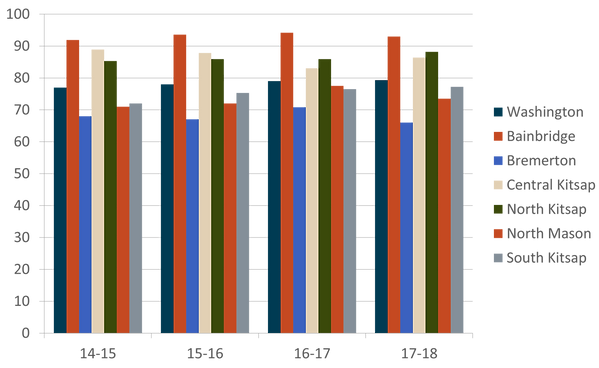top of page
 |
|---|
We use data to understand problems, identify goals, and track metrics that define progress toward the goals.
Contributing and Core Indicators: Core indicators are specific measures used to track progress on community-level outcomes. Contributing indicators are measured against data available in real time to indicate whether core indicators are improving. For example, early-grade reading (community-level outcome) is typically measured by a state assessment (core indicator), and chronic absenteeism can be used as a short-term predictor of students’ proficiency (contributing indicator).
Interactive Data Dashboard: The dashboard below uses data from multiple sources including the Washington Office of Superintendent of Public Instruction (OPSI) Report Card, and Washington Education and Research Data Center (ERDC) Dashboards. The data includes results in the aggregate form for all of the school districts within Graduate Strong's geographic scope. The data below the dashboard is disaggregated to display each school district separately.
Geographic Scope: The Graduate Strong Network includes six schools districts and one tribal compact school (Bainbridge Island, Bremerton, Central Kitsap, North Kitsap, North Mason, South Kitsap and Chief Kitsap Academy).

Source: 2019 Graduate Strong Community Convening
POVERTY WITHIN OUR DISTRICTS: What do know about the context/environmental factors or circumstances in which our students are living? One measure we see is poverty as represented by free and reduced lunch eligibility (FRL) rates ranging from less than 10% in BI to over 50 and 60% in North Mason and Bremerton respectively. The black line indicates Washington State's FRL rates with slow and incremental declines over time which is not the case with several of our local districts.

Source: 2019 Graduate Strong Community Convening
TRAUMA WITHIN OUR REGION: An additional context central to the lens we collectively look through is understanding the prevalence of trauma within our community. It is a bias to our collective work that we are very transparent about and believe in and utilize the NEAR sciences to inform our work. For those not familiar with the bundle of sciences we call NEAR it stands for (neuroscience, epigenetics, ACEs and resilience).

Source: 2019 Graduate Strong Community Convening
SUPPORT: The Healthy Youth Survey is a statewide survey administered every two years at the secondary level and provides lots of data regarding anything from academic performance, to mental health and wellness, substance use as well as items relevant to many risk and protective factors. The data below indicates the percentage of students in Kitsap County who report they have an adult to turn to when they feel sad or hopeless. We know from resilience research that one of the most crucial components in youth outcomes is the presence of at least one caring competent adult.

Source: 2019 Graduate Strong Community Convening
KINDERGARTEN READINESS: WaKIDS (Washington Kindergarten Inventory of Developing Skills) is an assessment of all entering kindergarteners who demonstrate the skills typical of entering kindergarteners in all six domains: social-emotional, physical, cognitive, language, literacy, and math. Since the WaKIDS assessment is widely agreed to be a very subjective measure, it is worth looking deeper into the data. However, we do see a strong correlation between readiness @ Kindergarten entry and performance on 3rd grade SBA (ELA/Math).

Source: 2019 Graduate Strong Community Convening
HIGH SCHOOL GRADUATION: Graduation rate is based on a cohort of students. The cohort is made up of all students who start 9th grade together. Students who transfer into or out of a school are added or removed from the cohort. If students stop attending school, they are counted as 'drop outs'. If students have met graduation requirements, they are counted as 'graduates'. If students don't graduate but are still attending, they are considered 'continuing'. Students are tracked through their 7th year in high school. The five year graduation rate includes students that graduated in 4 years and those that graduated in 5 years. A student that graduates high school is more likely to earn a higher income, less likely to be incarcerated, and have greater economic mobility across generations.

Source: 2019 Graduate Strong Community Convening
POST SECONDARY ENROLLMENT: First year enrollment is defined as having an enrollment record at a postsecondary institution (2 or 4 year, in state or out of state, both public and private) at some point in academic year following graduation, which is defined as the summer term immediately following graduation through spring term of the next calendar year. Students that enroll in apprenticeship programs administered by the WA State Dept of Labor & Industries are not included in this group. They are not reported separately, however, because they account for less than 0.5% of high school graduates and rarely exceed the redaction threshold.

Source: 2019 Graduate Strong Community Convening
POST SECONDARY COMPLETION: For class of 2009 – percent of students that obtained a certificate or degree or completion of an apprenticeship program within 8 years.

Source: 2019 Graduate Strong Community Convening
bottom of page
